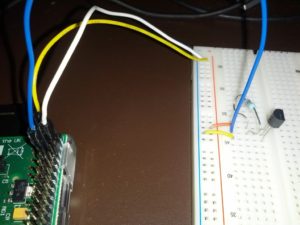First Temperature Readings with the Raspberry Pi and DS18B20 Chip
I got my Raspberry Pi reading temperatures with the DS18B20 chip.
I followed some of the guidance at the following two URLs (although I had to flip the chip as the instructions are a bit confusing - basically, look at the diagram on the 1st link below, and swap (pin 1 is 3, pin 3 is 1)):
- http://www.cl.cam.ac.uk/freshers/raspberrypi/tutorials/temperature/
- http://webshed.org/wiki/RaspberryPI_DS1820
My wiring:
Originally, according to the first URL above, I had the sensor chip the other way around, which caused it to heat way up seconds after turning on the Raspberry Pi. Thanks to the second link above which has an actual photo of his set up, I managed to get it going.
I refer to the pins on the DS18B20 chip as follows:
- Blue jumper is plugged into pin 7 (BCM GPIO 4) on the Raspberry Pi, and pin 2 on the DS18B20 chip
- White jumper is plugged into pin 6, which is a ground pin on the Raspberry Pi, and pin 3 on the DS18B20 chip
- Yellow jumper is plugged into pin 1, which is powered at 3.3V, and pin 1 on the DB18B20 chip
- The 4.7k ohms resister is connected to chips’ 1 and 2 of the DB18B20 chip
BCM? See https://projects.drogon.net/raspberry-pi/wiringpi/pins/
Kernel Modules
sudo modprobe w1-gpio
sudo modprobe w1-therm
Cating the device
The device files are located in /sys/bus/w1/devices/* where * = the serial number of the chip. In my case, the serial number is 28-0000032837ea. The file in that folder (the folder name is the S/N) that we need to cat is w1_slave:
$ cat /sys/bus/w1/devices/28-0000032837ea/w1_slave
a7 01 4b 46 7f ff 09 10 e0 : crc=e0 YES
a7 01 4b 46 7f ff 09 10 e0 t=26437
The line we’re interested is the 2nd, the value after the t=. Just pull this, divide by 1000, and we determine my room is a horribly hot 26.437 degrees Celsius!
Initial Code
The first link above has code written in Python. I am lame and prefer PHP, so I wrote the following:
if (!defined(“THERMOMETER_SENSOR_PATH”)) define(“THERMOMETER_SENSOR_PATH”, “/sys/bus/w1/devices/28-0000032837ea/w1_slave”);
// Open resource file for thermometer
$thermometer = fopen(THERMOMETER_SENSOR_PATH, “r”);
// Get the contents of the resource
$thermometerReadings = fread($thermometer, filesize(THERMOMETER_SENSOR_PATH));
// Close resource file for thermometer
fclose($thermometer);
// We’re only interested in the 2nd line, and the value after the t= on the 2nd line
preg_match("/t=(.+)/", preg_split("/n/", $thermometerReadings)[1], $matches);
$temperature = $matches[1] / 1000;
// Output the temperature
print $temperature;
?>
And there we are! Now it’s time to start plotting this info using RRD. More on that later.


